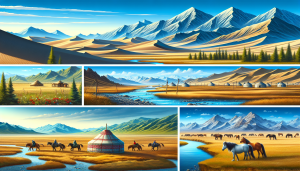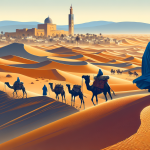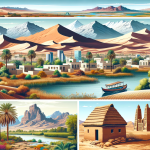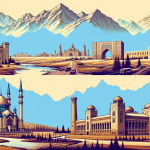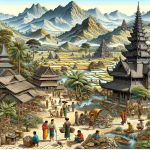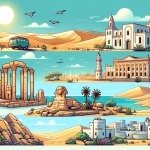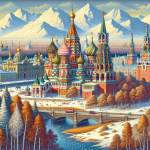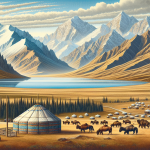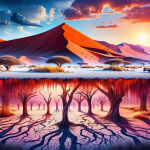Discovering Mongolia: An Unforgettable Journey into the Heart of Asia
Mongolia, a landlocked country in East Asia, offers a unique blend of natural beauty, rich history, and vibrant culture. Situated between Russia to the north and China to the south, Mongolia is often referred to as the “Land of the Eternal Blue Sky” due to its average of 250 sunny days a year. This vast nation is a haven for travelers seeking an authentic and unspoiled destination. With its endless steppes, rolling mountains, and the iconic Gobi Desert, Mongolia captures the imagination of adventurers and nature enthusiasts alike. The capital city, Ulaanbaatar, serves as the cultural and economic hub, blending modernity with traditional Mongolian customs. From the ancient history of Genghis Khan to the nomadic lifestyle still practiced today, Mongolia offers a unique travel experience that is both enriching and exhilarating. Whether you are exploring the remote wilderness or engaging with the warm and hospitable locals, a journey through Mongolia promises unforgettable memories and a deep connection with one of the world’s most fascinating cultures.
Exploring the Natural Wonders of Mongolia
Mongolia’s landscape is one of the most diverse and stunning in the world, making it a paradise for outdoor enthusiasts. The **Gobi Desert**, one of the largest deserts in the world, is a must-visit for its dramatic sand dunes, unique wildlife, and ancient dinosaur fossils. The **Khongoryn Els** sand dunes, also known as the “Singing Dunes,” are particularly famous for the musical sounds they produce when the wind blows. The **Altai Mountains**, located in the western part of the country, offer breathtaking views and are home to the elusive snow leopard. Trekking through these majestic mountains provides an opportunity to witness the beauty of Mongolia’s untouched wilderness.
Another natural wonder worth exploring is **Lake Khövsgöl**, often referred to as the “Blue Pearl of Mongolia.” This pristine freshwater lake is nestled in the northern part of the country and is surrounded by lush forests and snow-capped mountains. It is the perfect destination for those who enjoy water sports, fishing, and hiking. The lake is also home to a diverse range of flora and fauna, making it a haven for nature lovers. For a truly unique experience, consider visiting during the winter months when the lake freezes over, creating a magical winter wonderland.
The Gobi Desert: A Land of Extremes
The Gobi Desert is not just a barren wasteland; it is a region of incredible diversity and beauty. The desert spans over 1,295,000 square kilometers and is characterized by its vast expanses of sand dunes, rocky outcrops, and desert steppes. One of the most famous sites in the Gobi Desert is the **Flaming Cliffs**, also known as **Bayanzag**. This area is renowned for its rich deposits of dinosaur fossils and has been a key site for paleontological discoveries. The Flaming Cliffs get their name from the striking red and orange hues of the sandstone, which glow brilliantly at sunset.
Another highlight of the Gobi Desert is the **Yolyn Am Gorge**, a deep and narrow canyon that is home to a unique microclimate. Despite being located in a desert, the gorge often contains ice even during the summer months, creating a surreal and otherworldly landscape. The Gobi Desert is also home to a variety of wildlife, including the **Bactrian camel**, **Gobi bear**, and **wild ass**. Exploring this remote and rugged landscape provides a glimpse into the resilience and adaptability of life in one of the harshest environments on Earth.
The Altai Mountains: A Trekker’s Paradise
The Altai Mountains, located in western Mongolia, are a trekker’s paradise. This mountain range stretches across Mongolia, China, Kazakhstan, and Russia, and is known for its stunning landscapes and diverse ecosystems. The highest peak in the Altai Mountains is **Khüiten Peak**, which stands at 4,374 meters and offers a challenging climb for experienced mountaineers. The region is also home to several glaciers, including the **Potanin Glacier**, which is the longest glacier in Mongolia.
Trekking through the Altai Mountains provides an opportunity to explore remote and untouched landscapes, from lush meadows and alpine forests to rugged peaks and glacial valleys. The area is also rich in cultural heritage, with numerous petroglyphs and ancient burial sites scattered throughout the region. One of the most significant cultural sites in the Altai Mountains is the **Tsagaan Salaa** rock art complex, which contains thousands of petroglyphs dating back to the Bronze Age. The Altai Mountains are also home to several nomadic communities who continue to practice traditional herding and hunting techniques, providing a unique insight into the region’s cultural heritage.
Immersing in Mongolian Culture and History
Mongolia’s rich cultural heritage and history are deeply intertwined with the nomadic lifestyle that has been practiced for centuries. The Mongolian people are known for their hospitality and warmth, and visitors are often welcomed into their homes with open arms. One of the best ways to experience Mongolian culture is by staying in a **ger**, a traditional felt tent used by nomadic herders. Staying in a ger offers a unique and authentic experience, allowing visitors to immerse themselves in the daily life of a nomadic family.
Another way to experience Mongolian culture is by attending one of the many traditional festivals held throughout the year. The **Naadam Festival**, held in July, is the most famous and celebrates the “three manly games” of wrestling, horse racing, and archery. The festival dates back to the times of Genghis Khan and is a vibrant display of Mongolian culture and tradition. The **Tsagaan Sar** or Lunar New Year is another important festival that marks the beginning of the Mongolian lunar calendar. During this time, families gather to celebrate with traditional food, music, and dance.
The Legacy of Genghis Khan
No visit to Mongolia would be complete without exploring the legacy of Genghis Khan, one of the most famous and influential figures in world history. Genghis Khan founded the Mongol Empire in the early 13th century, which became the largest contiguous empire in history. His legacy can be seen throughout Mongolia, from the **Genghis Khan Statue Complex** to the **National Museum of Mongolia** in Ulaanbaatar, which houses numerous artifacts and exhibits related to his life and the Mongol Empire.
The Genghis Khan Statue Complex, located just outside of Ulaanbaatar, is one of the most iconic landmarks in Mongolia. The complex features a 40-meter-tall statue of Genghis Khan on horseback, which is the largest equestrian statue in the world. Visitors can take an elevator to the top of the statue for panoramic views of the surrounding countryside. The complex also includes a museum and visitor center that provides insight into the life and legacy of Genghis Khan.
Traditional Mongolian Arts and Crafts
Mongolia has a rich tradition of arts and crafts, with many unique and distinctive forms of artistic expression. One of the most famous forms of Mongolian art is **thangka painting**, a traditional Buddhist art form that involves intricate and detailed paintings on silk or cotton. Thangka paintings often depict Buddhist deities, mandalas, and scenes from the life of the Buddha, and are used as aids for meditation and religious practice.
Another traditional Mongolian craft is **felt making**, which is used to create a variety of items, from clothing and accessories to rugs and wall hangings. Felt making is an ancient craft that has been practiced by Mongolian nomads for centuries, and involves the process of matting and pressing wool fibers together to create a dense and durable fabric. Visitors to Mongolia can learn about the craft of felt making by visiting local workshops and even try their hand at creating their own felt items.
Experiencing the Nomadic Lifestyle
One of the most unique aspects of traveling in Mongolia is the opportunity to experience the nomadic lifestyle that has been practiced for centuries. Nomadic herding is still a way of life for many Mongolian families, and visitors can gain insight into this traditional way of living by staying with a nomadic family. Staying in a ger, or traditional felt tent, offers a glimpse into the daily life of a nomadic herder, from milking yaks and sheep to tending to livestock and preparing traditional meals.
The nomadic lifestyle is deeply connected to the natural environment, and the movement of herders and their livestock is dictated by the seasons and the availability of pasture. This way of life has fostered a deep respect for nature and the land, and nomadic families often have a wealth of knowledge about the local flora and fauna. Visitors can learn about traditional herding techniques, Mongolian horsemanship, and the importance of livestock in Mongolian culture.
Staying in a Ger Camp
Staying in a ger camp is one of the best ways to experience the nomadic lifestyle and the stunning landscapes of Mongolia. Ger camps are scattered throughout the country, from the vast steppes of the Gobi Desert to the lush valleys of the Altai Mountains. These camps offer a unique and authentic accommodation experience, with traditional felt tents that provide a comfortable and cozy retreat.
Ger camps often include communal dining areas where visitors can enjoy traditional Mongolian meals, such as **buuz** (steamed dumplings) and **khuushuur** (fried meat pies). Many camps also offer activities such as horseback riding, archery, and hiking, allowing visitors to explore the surrounding landscapes and immerse themselves in the natural beauty of Mongolia. Staying in a ger camp provides a unique and unforgettable experience, offering a glimpse into the traditional nomadic lifestyle and the breathtaking landscapes of Mongolia.
Mongolian Horsemanship
Horses have played a central role in Mongolian culture for centuries, and Mongolian horsemanship is renowned for its skill and expertise. The Mongolian horse is a small but hardy breed, well-suited to the harsh and rugged terrain of the country. Nomadic herders rely on their horses for transportation, herding livestock, and even hunting. Visitors to Mongolia can experience the thrill of riding a Mongolian horse and learn about the traditional techniques of Mongolian horsemanship.
One of the best ways to experience Mongolian horsemanship is by attending a traditional horse racing event. Horse racing is one of the “three manly games” celebrated during the Naadam Festival, and races often cover long distances, with riders as young as five years old. The races are a vibrant and thrilling spectacle, showcasing the skill and endurance of both the horses and their riders. Visitors can also participate in horseback riding tours, exploring the stunning landscapes of Mongolia on horseback and gaining a deeper appreciation for the country’s equestrian heritage.
Practical Tips for Traveling in Mongolia
Traveling in Mongolia can be a rewarding and unforgettable experience, but it is important to be prepared for the unique challenges and conditions of the country. Here are some practical tips to help you make the most of your journey:
- **Plan Ahead**: Mongolia is a vast and sparsely populated country, and travel between destinations can be time-consuming. Plan your itinerary carefully and allow plenty of time to explore each region.
- **Pack Appropriately**: The weather in Mongolia can be extreme, with hot summers and cold winters. Pack layers of clothing to accommodate the changing temperatures, and don’t forget essentials such as sunscreen, a hat, and a good pair of walking shoes.
- **Stay Connected**: While major cities like Ulaanbaatar have good internet and mobile coverage, remote areas may have limited connectivity. Consider purchasing a local SIM card and downloading offline maps and translation apps before your trip.
- **Respect Local Customs**: The Mongolian people are known for their hospitality, and it is important to show respect for their customs and traditions. Always remove your shoes before entering a ger, and be mindful of local etiquette and practices.
- **Be Prepared for Rough Terrain**: Many roads in Mongolia are unpaved and can be challenging to navigate. Consider hiring a local guide or driver to help you navigate the terrain and ensure a safe and enjoyable journey.
By following these tips and embracing the unique culture and landscapes of Mongolia, you can ensure a memorable and enriching travel experience. Whether you are exploring the natural wonders of the Gobi Desert, immersing yourself in the rich cultural heritage of Ulaanbaatar, or experiencing the traditional nomadic lifestyle, Mongolia offers a truly unforgettable journey into the heart of Asia.
For more information on planning your trip to Mongolia, visit [Lonely Planet’s Mongolia Travel Guide](https://www.lonelyplanet.com/mongolia).
